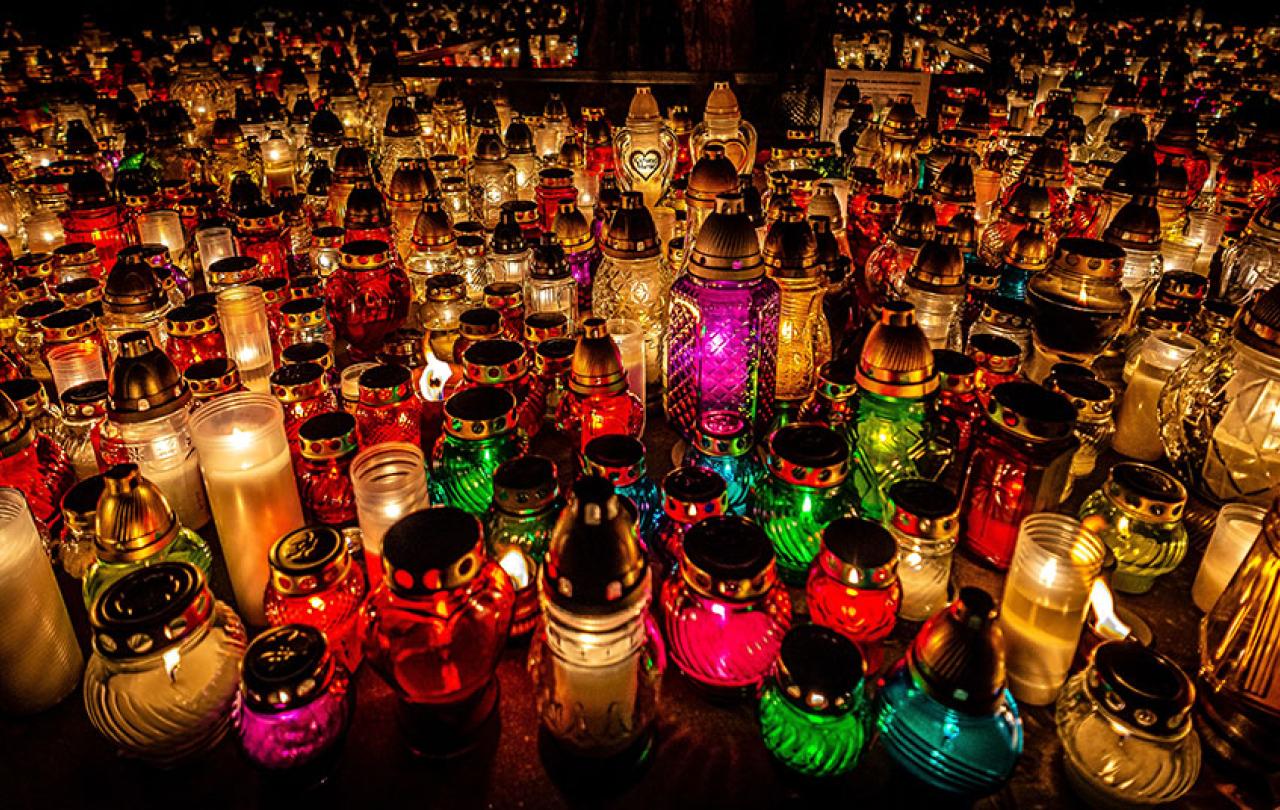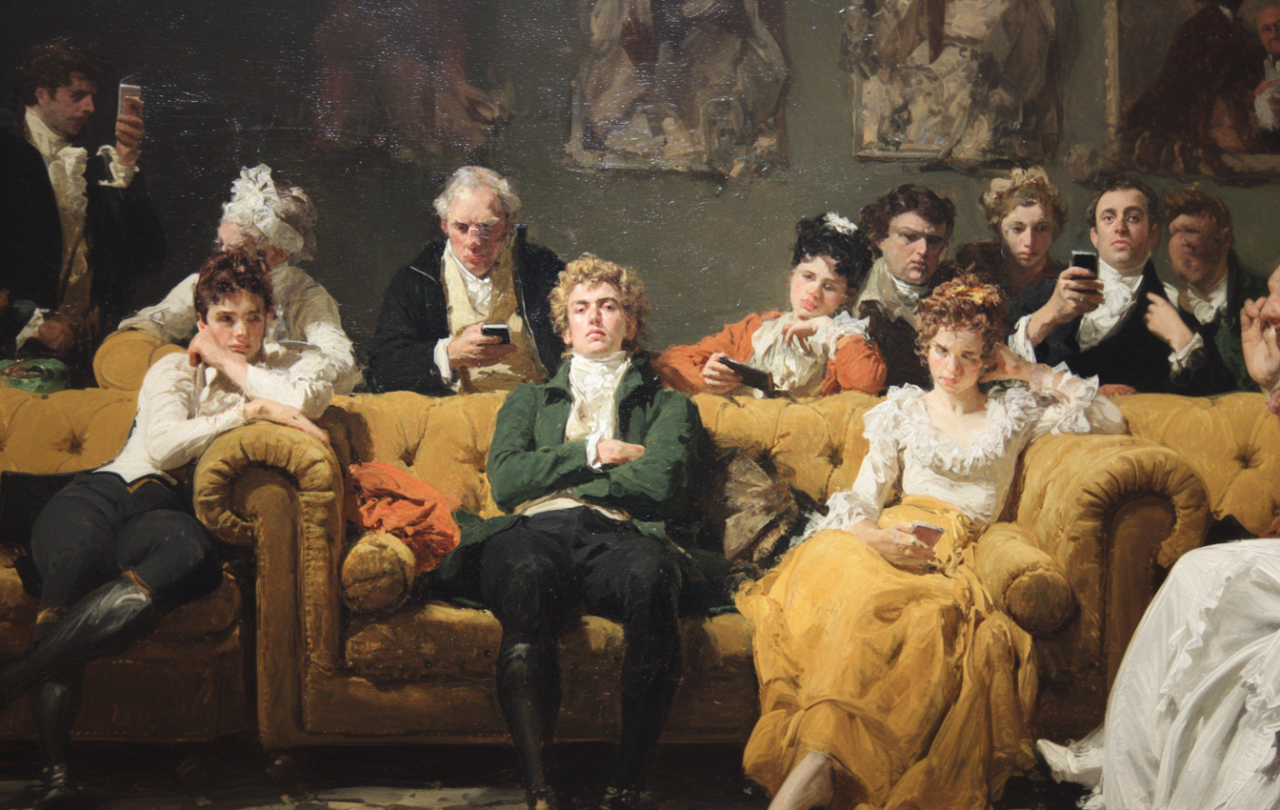
‘The last enemy that shall be destroyed is death.’
Seeing things two ways at the same time doesn’t mean ambivalence. Christianity has two things to say about death, and it says both forcefully. They particularly come to mind during November, as the season of the year when we remember the dead. In this month we get the modern secularised rituals of Hallowe’en, but we also get Remembrance Sunday, when we think of those who fell in war; and on 2 November, we have All Souls’ Day, when ‘the faithful departed’ are recalled, and in many traditions, prayed for.
Christianity’s two entwined attitudes to death are lament and hope. On the one hand, death is a shadow; on the other, a light has dawned that will banish that shadow. Both aspects are in that line from St Paul:
‘The last enemy that shall be destroyed is death.’
Death is our enemy; death is slated for destruction.
Whatever a popular funeral poem might claim, death is not ‘nothing at all’. That poem has been suggested a few times when I’ve been planning a funeral. It’s never stayed in the draft order of service longer than it’s taken me to ask the question ‘But do you really think that death is nothing at all?’
Unlike our benighted predecessors, ancient and mediaeval, don’t we now understand that death is natural, just part of being the sort of creatures we are?
I take the opposite approach to funerals. I do not treat death as ‘nothing at all’. I wear black vestments: I do not assume that mourners are ready, only a week or two into their bereavement, to skip to the bright hope of white as a liturgical colour. I make the liturgy solemn. I avoid circumlocutions like ‘he’s moved on’ or ‘she has passed’ (somehow popular at present). No: someone has died, and even if that came after a long illness or a long life, a death is a loss.
The idea of death as enemy, though – ‘the most fearful of bodily evils’ (Thomas Aquinas) – might look out of date in the twenty-first century. Unlike our benighted predecessors, ancient and mediaeval, don’t we now understand that death is natural, just part of being the sort of creatures we are?
It’s almost always a mistake to underestimate our forebears. They knew that we are animals, but also said that we are animals of an odd sort: we are ‘rational animals’. That left them with a conundrum (and here I continue to have Aquinas in mind). On the one hand, we are animals, and animals are mortal, so that makes death natural. On the other hand, Christianity also insists that death is a wrench, a disjunction, an affront.
Reconciliation for this tension rests on that odd status of the human being, as a rational animal. We are animals, but also the sort of self-aware animals who are made for a relationship with God: suited for it, called to it. One model for that relationship, remarkably, has been friendship, with Moses as an example: ‘So the Lord used to speak to Moses face to face, as one speaks to a friend.’ That sort of relationship, that sort of seeing God face to face, would confer immortality on our naturally mortal bodies (‘when we see him, we shall be like him, for we shall see him as he is’). Thus, both parts of the conundrum are true: as animals, we are naturally mortal, yet our animality is called to a destiny beyond its nature. Our tragedy is not that we are animals, but that we are rational animals foolish enough to turn from God, and from the light of immortality.
The message of the Incarnation and the hope of the resurrection turned something around for early Christians. They no longer found dead bodies frightening.
That’s the first half of our opening phrase: death is our enemy because, although mortal by nature, we were originally called to something beyond nature, but lost it. God was turned towards us, but we turned away. However, enmity, tragedy, and loss are not the whole story, and they are certainly not the end of the story. There is also death’s destruction. That’s what the life, death, and resurrection of Christ were about. If death is our enemy, then it’s a routed enemy, overcome, although not fully destroyed, until God recreates the world.
Christians can be so excited about the prospect of death’s destruction that they forget that this destruction is still a promise, and we still live under its sway. For now, the hope and the sadness lie woven together. That is why we read in the New Testament about ‘not grieving as others do who have no hope’. I don’t take that as a blanket injunction against grieving (death is still our enemy, after all), but as standing only against the kind of grief that has no hope (because death’s destruction is assured). Again, here are the two strands, woven together. We also see that two-sidedness in a funeral prayer used by Eastern Orthodox Christians (and at the funeral of the HM Queen Elizabeth II), the kontakion of the dead. Its final lines put place wrenching tears right next to the church’s great word of praise and celebration, ‘Alleluia’:
All we go down to the dust;
weeping o’er the grave we make our song:
Alleluia, alleluia, alleluia.
This duality in Christian attitudes to death shows up in how Christians treat the bodies of the dead. We probably take burial practices for granted, but the idea of treating the bodies of the dead with utmost care and dignity was a point that Christianity really belaboured. Christ, for instance, had given a list of six good deeds in the Parable of the Sheep and the Goats: feeding the hungry, giving drink to the thirsty, clothing the naked, sheltering travellers, visiting the sick, and visiting prisoners. It would be a bold decision to add to any list draw up by Christ, but the church did it, adding a seventh ‘act of corporeal mercy’: burying the dead.
Christianity is definitively the religion of the Incarnation: of God taking up human flesh. Bodies therefore matter. Talk of casting off the body, as if the body were just some old cloak that the soul has outgrown, is not something Christians say. We are bodily creatures, so Christian hope is for the resurrection of the body. (So also – I should add for completeness – is Christian doom also bodily. Those who die at enmity with God and the good, the faith insists, turning down the offer of reconciliation, face the consequences in the resurrected body.)
The message of the Incarnation and the hope of the resurrection turned something around for early Christians. They no longer found dead bodies frightening. In the ancient world, bodies were to be buried outside the city, cast out from the human community. Christians changed that, and started burying their loved ones inside the city. Bodies were to be treasured, not feared. The bodies of their heroes – those who excelled in virtue, and especially the martyrs – were brought right into their churches. Before long, no altar (the communion table) was quite proper unless it was built over the body of a martyr or other saint, or at the very least contained some part or relic.
Veneration of relics has not been so common in the Church of England (the church to which I belong) since the Reformation, nor in the wider Anglican Communion. Slowly, however, it has edged its way back. In 2002, the cathedral where I’m a canon, St Albans, received a shoulder blade of St Alban, England’s first martyr, the gift of one of the dozen remarkable Romanesque churches in Cologne. That bone gets considerable honour on the weekend closest to his feast day (22 June). Relics are also familiar in the church in Philadelphia where I currently celebrate the Eucharist once or twice per week. The altars are usually at least lightly decked with relics. During Eastertide, they groan under the weight of them, including some impressive whole-bone affairs. Only in Advent and Lent – penitential seasons – do the relics disappear to the sacristy, replaced with statues of the prophets in Advent.
It’s easy to grow accustomed to relics after a while. I should remind myself of their strangeness. Defying any trend in religious thought down the ages to denigrate the body in favour of the soul, here the body is holy, recognised as the site of God’s great works. Here, dead bodies are no longer to be feared. They are the most precious things the church owns, and threaten no contamination. Or, rather, if they suggest any contagion, it is a contagion of the good.
Care towards the bodies of the dead reflects both poles of Christian attitudes to death. On the one hand, Christians have preserved the bodies of the dead with great care because death is an affront. Death is the enemy that falls upon us all, even the most holy among us. Lamenting that loss, we keep bodies safe until it is reversed. And there is also the other side of the Christian attitude to death: alongside lament there is hope in death’s destruction.
Christianity, at its wisest, has not skipped through lamentation too quickly, but neither has it given lamentation the final word. Day-by-day funeral practice probably connects most clearly with the sadness, although the hope is woven through. The place of relics in many strands of Christianity (although by no means all), swings more towards an emphasis on death’s defeat. It rejoices in having among us, in all those slivers of bone, fragments poised towards Resurrection, when ‘death shall be no more’.





